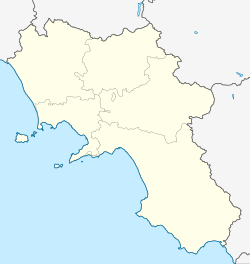Gragnano | |
|---|---|
| Comune di Gragnano | |
 Church of Santa Maria of the Assumption. | |
| Coordinates: 40°41′N14°31′E / 40.683°N 14.517°E | |
| Country | Italy |
| Region | Campania |
| Metropolitan city | Naples (NA) |
| Frazioni | Aurano, Caprile, Castello, Iuvani |
| Government | |
| • Mayor | Paolo Cimmino |
| Area | |
• Total | 14.6 km2 (5.6 sq mi) |
| Elevation | 141 m (463 ft) |
| Population (31 June 2015) [2] | |
• Total | 29,310 |
| • Density | 2,000/km2 (5,200/sq mi) |
| Demonym | Gragnanesi |
| Time zone | UTC+1 (CET) |
| • Summer (DST) | UTC+2 (CEST) |
| Postal code | 80054 |
| Dialing code | 081 |
| Patron saint | Saint Sebastian |
| Saint day | January 20 |
| Website | Official website |
Gragnano is a hill town and comune (municipality) in the Metropolitan City of Naples, in southern Italian region of Campania. It is located about 30 kilometres (19 miles) southeast of Naples, between a mountain crest and the Amalfi Coast.
Contents
Gragnano borders the following municipalities: Agerola, Casola di Napoli, Castellammare di Stabia, Lettere, Pimonte, Ravello, Sant'Antonio Abate, Santa Maria la Carità, Scala.
In 1169 its name was added to the title of the bishopric of nearby Lettere, which was thus renamed Roman Catholic Diocese of Lettere-Gragnano, but Gragnano never had a co-cathedral and its title was dropped when the suppressed see was nominally restored as titular bishopric of Lettere. [3]




